Terry Odell's Blog, page 273
September 5, 2011
Using Multiple POV Characters
I hope you're having a safe and happy Labor Day weekend. A reminder: Today's the last day to take advantage of my
e-book giveaway
.
And another reminder that I'm hosting a month-long discussion of characters at Coffee Time Romance . It's free, and you can drop in any time. And thinking about characters leads me to today's post.
 When authors put a character on the page, they've made a decision as to whether or not it will be a POV character. In my opinion, if you're going to make a character a POV character, there needs to be a good reason for it.
When authors put a character on the page, they've made a decision as to whether or not it will be a POV character. In my opinion, if you're going to make a character a POV character, there needs to be a good reason for it.
If the only reason you're adding a POV character is to show his thoughts, then you should probably re-think it and see if there's another way to get that information to the reader. We live in a single POV world. A POV character has to be critical for plot advancement, not author convenience.
In romance, it's a 'given' that there will be two POV protagonists: hero and heroine. There might be more, but there are always at least two.
Mysteries are another genre. Most mysteries I read feature some kind of crime-solving detective, and often, they're part of a series where the same character heads up the entire series.
And then there's suspense, which by nature, requires more than one POV character, because the reader needs to know more than the protagonist—hence, the suspense.
A recent read falls into the suspense category (the back cover calls it a thriller, but I disagree with the recent overuse of the term). As someone who definitely prefers to connect with characters, I tried to step back and examine why the book works for me.
Because the author is using so many POV characters, there's not a single character to get behind, to care about. Technically, as a character-focused reader and writer, I shouldn't be enjoying the book. So why am I? I think it's because despite the complexities of writing multiple POV characters, the author has worked to avoid distancing readers.
1. Readers should connect with each POV character, one way or the other. Show us the stakes.
For example, there's the kindly rancher who harbors the children who claim to have witnessed a murder. They're afraid because the killers have seen them. We know the children are telling the truth, because we've seen it. The rancher's conflict is whether or not to reveal that he has the children. He knows their mother is frantic with worry. But can he trust the people who are supposed to be the good guys when the children say they're really the bad guys?
2. Character back story needs to be woven in with the same care you'd take for a single or dual POV character story.
To layer character depth here, long before the rancher and the children come into contact, we see that he's in danger of losing his ranch, that he has had marital problems, and he's lost his son. In short, he's a 'real' person with real-life issues beyond wondering what to do about two kids who need help.
The flip side to having so many POV characters is that we're constantly being shifted from one to the other. If a reader doesn't connect with one of the characters, it's quite possible they're going to skip over those scenes. Each character requires its own introduction, creating even more opportunities for the author to lose readers with dumping back story so many times. The author has to make sure we don't wonder why he's introducing the rancher's financial and marital problems when it appears there's no connection to the mystery.
3. Transitions between characters must be logical and clearly ground the reader in the POV character's head.
This is more of a challenge in books with many POV characters. Simply because switches are clearly marked with scene breaks or extra spacing doesn't make things flow smoothly. The reader still has to regroup and figure out which character's head we're in now.
An author wants a reader to turn pages. Wondering what happens in the story is definitely a reason a reader will keep going. But making your reader wonder what's happening to the character in addition to following the story is even better.
Tomorrow, my guest is author Kelly McClymer who's going to discuss the downside she's encountered with her expansion to indie publishing
Like this post? Please share by clicking one of the links below.
And another reminder that I'm hosting a month-long discussion of characters at Coffee Time Romance . It's free, and you can drop in any time. And thinking about characters leads me to today's post.
 When authors put a character on the page, they've made a decision as to whether or not it will be a POV character. In my opinion, if you're going to make a character a POV character, there needs to be a good reason for it.
When authors put a character on the page, they've made a decision as to whether or not it will be a POV character. In my opinion, if you're going to make a character a POV character, there needs to be a good reason for it.If the only reason you're adding a POV character is to show his thoughts, then you should probably re-think it and see if there's another way to get that information to the reader. We live in a single POV world. A POV character has to be critical for plot advancement, not author convenience.
In romance, it's a 'given' that there will be two POV protagonists: hero and heroine. There might be more, but there are always at least two.
Mysteries are another genre. Most mysteries I read feature some kind of crime-solving detective, and often, they're part of a series where the same character heads up the entire series.
And then there's suspense, which by nature, requires more than one POV character, because the reader needs to know more than the protagonist—hence, the suspense.
A recent read falls into the suspense category (the back cover calls it a thriller, but I disagree with the recent overuse of the term). As someone who definitely prefers to connect with characters, I tried to step back and examine why the book works for me.
Because the author is using so many POV characters, there's not a single character to get behind, to care about. Technically, as a character-focused reader and writer, I shouldn't be enjoying the book. So why am I? I think it's because despite the complexities of writing multiple POV characters, the author has worked to avoid distancing readers.
1. Readers should connect with each POV character, one way or the other. Show us the stakes.
For example, there's the kindly rancher who harbors the children who claim to have witnessed a murder. They're afraid because the killers have seen them. We know the children are telling the truth, because we've seen it. The rancher's conflict is whether or not to reveal that he has the children. He knows their mother is frantic with worry. But can he trust the people who are supposed to be the good guys when the children say they're really the bad guys?
2. Character back story needs to be woven in with the same care you'd take for a single or dual POV character story.
To layer character depth here, long before the rancher and the children come into contact, we see that he's in danger of losing his ranch, that he has had marital problems, and he's lost his son. In short, he's a 'real' person with real-life issues beyond wondering what to do about two kids who need help.
The flip side to having so many POV characters is that we're constantly being shifted from one to the other. If a reader doesn't connect with one of the characters, it's quite possible they're going to skip over those scenes. Each character requires its own introduction, creating even more opportunities for the author to lose readers with dumping back story so many times. The author has to make sure we don't wonder why he's introducing the rancher's financial and marital problems when it appears there's no connection to the mystery.
3. Transitions between characters must be logical and clearly ground the reader in the POV character's head.
This is more of a challenge in books with many POV characters. Simply because switches are clearly marked with scene breaks or extra spacing doesn't make things flow smoothly. The reader still has to regroup and figure out which character's head we're in now.
An author wants a reader to turn pages. Wondering what happens in the story is definitely a reason a reader will keep going. But making your reader wonder what's happening to the character in addition to following the story is even better.
Tomorrow, my guest is author Kelly McClymer who's going to discuss the downside she's encountered with her expansion to indie publishing
Like this post? Please share by clicking one of the links below.
Published on September 05, 2011 04:00
September 3, 2011
Labor Day Weekend Giveaway
Don't miss out on a chance for a free download of either WHAT'S IN A NAME? or DANGER IN DEER RIDGE. Offer expires Monday, Sept. 5th, 2011. Click
here
for details.
Like this post? Please share by clicking one of the links below.
Like this post? Please share by clicking one of the links below.
Published on September 03, 2011 04:00
September 2, 2011
Friday Field Trip - Pikes Peak
Today I'm over at
Savvy Authors
with a blog about R.U.E.
Yesterday I mentioned that Hubster took charge of our anniversary reservations. We stayed at the Cliff House in Manitou Springs, which was a very elegant change from Divide establishments. Wait. There are no hotels in Divide. Anyway, here's a glimpse of our room. Note the turndown service in the last one. And something I've never seen before. They laid little foot mats at each side of the bed. Not that the floor was cold--it's summer and there was carpeting.


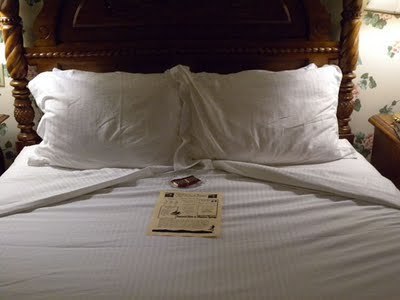
We wandered around town for a while. This is one of the old cog railroad engines.
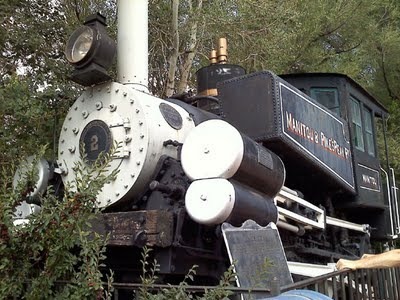
The next day, we went to the Cog Railway for our trip up to the Pikes Peak Summit. This is what the new trains look like:

And here are some views from the top:
End of the line:





I'm not sure this will work, but I've uploaded all the Pikes Peak pictures into a Google/Picasa album thingie. This should be the LINK. If it doesn't work, let me know and I'll try to see about fixing it.
Have a safe Labor Day Weekend, everyone!
Like this post? Please share by clicking one of the links below.
Yesterday I mentioned that Hubster took charge of our anniversary reservations. We stayed at the Cliff House in Manitou Springs, which was a very elegant change from Divide establishments. Wait. There are no hotels in Divide. Anyway, here's a glimpse of our room. Note the turndown service in the last one. And something I've never seen before. They laid little foot mats at each side of the bed. Not that the floor was cold--it's summer and there was carpeting.



We wandered around town for a while. This is one of the old cog railroad engines.

The next day, we went to the Cog Railway for our trip up to the Pikes Peak Summit. This is what the new trains look like:

And here are some views from the top:
End of the line:





I'm not sure this will work, but I've uploaded all the Pikes Peak pictures into a Google/Picasa album thingie. This should be the LINK. If it doesn't work, let me know and I'll try to see about fixing it.
Have a safe Labor Day Weekend, everyone!
Like this post? Please share by clicking one of the links below.
Published on September 02, 2011 04:00
September 1, 2011
The Currency of Romance
What I'm reading: The Arranger, by L.J. Sellers
Don't forget my book giveaway . It runs through Labor Day.
 Last weekend, Jaxine Daniels spoke to my local RWA chapter. Her topic: The A,B, C's of Romance Heroes. After going through different interpretations of different types of heroes, including the all-too-prevalent alpha male, and quoting a good number of authors, all of whom had their own categories and definitions, the takeaway gem was that there is no need to sweat whether your hero is Alpha, Beta, or Theta. Or a Thinker, Ruler, Warrior, or Sorcerer. Or a Chief, Bad Boy, Best Friend or Charmer.
Last weekend, Jaxine Daniels spoke to my local RWA chapter. Her topic: The A,B, C's of Romance Heroes. After going through different interpretations of different types of heroes, including the all-too-prevalent alpha male, and quoting a good number of authors, all of whom had their own categories and definitions, the takeaway gem was that there is no need to sweat whether your hero is Alpha, Beta, or Theta. Or a Thinker, Ruler, Warrior, or Sorcerer. Or a Chief, Bad Boy, Best Friend or Charmer.
Write the character you love. Let others worry about where to pigeonhole him. I would say that her description of the Warrior Poet seems to be closest to the heroes I write and love to read about. They're strong when they need to be, but aren't afraid to show their sensitive, loving side. They have the courage to walk away from an unnecessary fight.
However, the biggest gem I carried away from her presentation was that women express their feelings using words, while men show their feelings in actions, using their currency. In this context, currency is what matters to a person. (It's almost another example of "show, don't tell.")
An example: The man absolutely loves fishing. A perfect day (or week) would be spent on the river, lake, or boat. For him, inviting the woman on a fishing trip is the way he shows her he cares about her. She may think otherwise, but he's actually saying, "I love you."
Another example: Jaxine's husband accompanied her to her talk and after setting up her computer/projector system, sat in the back of the room until she was finished, when he dismantled everything. It's highly unlikely he enjoyed listening to her talk, but he was paying her in his currency—helping her with setup, something she wasn't comfortable doing on her own.
Or take the Hubster. For our recent anniversary celebration, he came up with the idea and made all the reservations. Normally, he prefers if I take care of things like this, but once he confirmed that I was happy with his suggestion--a night at the Cliff House at the foot of Pike's Peak, with dinner and then a ride on the cog railroad the next morning--he went ahead and made the requisite calls (or web searches) so that we had reservations for everything. And since I know how much he dislikes doing it, the payoff was that much greater.
The lesson here: The heroine in your story must learn to interpret and understand the way the hero is showing that he cares for her.
A few other tidbits:
Powerful characters create powerful drama
Create conflicts. Take away what your hero values most. She gave an example that to Donald Trump, being second best is failure. Others might consider themselves successful at a much "lower" level.
Find out what it would take to make your hero violate his own sense of honor or his own beliefs. Then shove it at him!
You can create a hero OR a villain using the same set of circumstances.
So, what examples, real life or fiction, of men using their own currency can you share?
Tomorrow, we'll go to the top of Pikes Peak.
Like this post? Please share by clicking one of the links below.
Don't forget my book giveaway . It runs through Labor Day.
 Last weekend, Jaxine Daniels spoke to my local RWA chapter. Her topic: The A,B, C's of Romance Heroes. After going through different interpretations of different types of heroes, including the all-too-prevalent alpha male, and quoting a good number of authors, all of whom had their own categories and definitions, the takeaway gem was that there is no need to sweat whether your hero is Alpha, Beta, or Theta. Or a Thinker, Ruler, Warrior, or Sorcerer. Or a Chief, Bad Boy, Best Friend or Charmer.
Last weekend, Jaxine Daniels spoke to my local RWA chapter. Her topic: The A,B, C's of Romance Heroes. After going through different interpretations of different types of heroes, including the all-too-prevalent alpha male, and quoting a good number of authors, all of whom had their own categories and definitions, the takeaway gem was that there is no need to sweat whether your hero is Alpha, Beta, or Theta. Or a Thinker, Ruler, Warrior, or Sorcerer. Or a Chief, Bad Boy, Best Friend or Charmer. Write the character you love. Let others worry about where to pigeonhole him. I would say that her description of the Warrior Poet seems to be closest to the heroes I write and love to read about. They're strong when they need to be, but aren't afraid to show their sensitive, loving side. They have the courage to walk away from an unnecessary fight.
However, the biggest gem I carried away from her presentation was that women express their feelings using words, while men show their feelings in actions, using their currency. In this context, currency is what matters to a person. (It's almost another example of "show, don't tell.")
An example: The man absolutely loves fishing. A perfect day (or week) would be spent on the river, lake, or boat. For him, inviting the woman on a fishing trip is the way he shows her he cares about her. She may think otherwise, but he's actually saying, "I love you."
Another example: Jaxine's husband accompanied her to her talk and after setting up her computer/projector system, sat in the back of the room until she was finished, when he dismantled everything. It's highly unlikely he enjoyed listening to her talk, but he was paying her in his currency—helping her with setup, something she wasn't comfortable doing on her own.
Or take the Hubster. For our recent anniversary celebration, he came up with the idea and made all the reservations. Normally, he prefers if I take care of things like this, but once he confirmed that I was happy with his suggestion--a night at the Cliff House at the foot of Pike's Peak, with dinner and then a ride on the cog railroad the next morning--he went ahead and made the requisite calls (or web searches) so that we had reservations for everything. And since I know how much he dislikes doing it, the payoff was that much greater.
The lesson here: The heroine in your story must learn to interpret and understand the way the hero is showing that he cares for her.
A few other tidbits:
Powerful characters create powerful drama
Create conflicts. Take away what your hero values most. She gave an example that to Donald Trump, being second best is failure. Others might consider themselves successful at a much "lower" level.
Find out what it would take to make your hero violate his own sense of honor or his own beliefs. Then shove it at him!
You can create a hero OR a villain using the same set of circumstances.
So, what examples, real life or fiction, of men using their own currency can you share?
Tomorrow, we'll go to the top of Pikes Peak.
Like this post? Please share by clicking one of the links below.
Published on September 01, 2011 04:00
August 31, 2011
What's Cooking Wednesday, Black Bean and Corn Salad
Thanks to Marcos for yesterday's post. And don't forget: there's still time to get a FREE download of either DANGER IN DEER RIDGE or WHAT'S IN A NAME?
The Hubster hooked up with a group in our community that goes to breakfast once a week. They're called the ROMEOs (Retired Old Men Eating Out). Once a month, they have a pot luck supper which includes spouses. After going to my first, I decided that unless I wanted to eat food that seemed to require mayonnaise, cream, sour cream, or some other gooey, high-fat binder, I needed to bring something a bit closer to healthy as my contribution. And if they don't eat much of it, that means I get to bring home the leftovers.
Here's what I made last time—a compilation of several salad recipes. And, since it's just a salad, feel free to adjust with ingredients more to your liking. It's not like baking, where everything has to be exact. If you like things spicier or not-so-spicy, adjust the seasonings.
Black Bean & Corn Salad
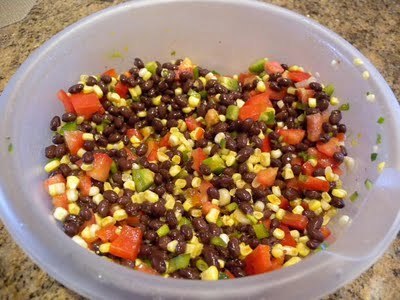
2 cans black beans, rinsed and drained
2 ears corn, kernels removed. (If fresh corn isn't in season, just defrost a package of frozen corn. No cooking either way).
½ red bell pepper, chopped
½ green bell pepper chopped
1 jalapeño pepper, finely diced
3 scallions, sliced
2 tomatoes, chopped
Dressing:
½ c. apricot preserves
3 T lime juice
3 T olive or salad oil
1 t. chili powder (adjust to taste; chili powders differ in strength)
¼ t cumin
1 t. Chili lime seasoning (I used Cholula)
Salt, pepper to taste
Note: I'm one of those who thinks cilantro tastes like soap, so I don't use it, although if you like the flavor, several of the recipes I mingled to make this call for it. Again, it's up to your taste.
Mix everything together. I do it the day before so everything blends.
If you're bringing it to a pot luck, you can just put it all in a bowl, or you can serve it over a bed of lettuce. Or you can add shredded lettuce to the whole shebang right before serving.
Like this post? Please share by clicking one of the links below.
The Hubster hooked up with a group in our community that goes to breakfast once a week. They're called the ROMEOs (Retired Old Men Eating Out). Once a month, they have a pot luck supper which includes spouses. After going to my first, I decided that unless I wanted to eat food that seemed to require mayonnaise, cream, sour cream, or some other gooey, high-fat binder, I needed to bring something a bit closer to healthy as my contribution. And if they don't eat much of it, that means I get to bring home the leftovers.
Here's what I made last time—a compilation of several salad recipes. And, since it's just a salad, feel free to adjust with ingredients more to your liking. It's not like baking, where everything has to be exact. If you like things spicier or not-so-spicy, adjust the seasonings.
Black Bean & Corn Salad

2 cans black beans, rinsed and drained
2 ears corn, kernels removed. (If fresh corn isn't in season, just defrost a package of frozen corn. No cooking either way).
½ red bell pepper, chopped
½ green bell pepper chopped
1 jalapeño pepper, finely diced
3 scallions, sliced
2 tomatoes, chopped
Dressing:
½ c. apricot preserves
3 T lime juice
3 T olive or salad oil
1 t. chili powder (adjust to taste; chili powders differ in strength)
¼ t cumin
1 t. Chili lime seasoning (I used Cholula)
Salt, pepper to taste
Note: I'm one of those who thinks cilantro tastes like soap, so I don't use it, although if you like the flavor, several of the recipes I mingled to make this call for it. Again, it's up to your taste.
Mix everything together. I do it the day before so everything blends.
If you're bringing it to a pot luck, you can just put it all in a bowl, or you can serve it over a bed of lettuce. Or you can add shredded lettuce to the whole shebang right before serving.
Like this post? Please share by clicking one of the links below.
Published on August 31, 2011 04:00
August 30, 2011
Love and Murder Walk Hand-In-Hand
Today Marcos M. Villatoro is my guest at Terry's Place. He's got some thoughts about how murder's just not the same without a little romance thrown in (or better, a lot!).
No one wants to read a happy novel. We read novels because of their conflict. It's conflict that makes us turn the page, greedy to find out what's going to happen next.
And two of the most tantalizing stress factors in life: Murder and Romance. Murder is chaos, a breakdown in the order of our world. And romance is, well, it's chaos too. Even a good marriage has its share of turmoil.
So when you put the two hand in hand, you've got a real page-turner.
There are several examples of this. One of my favorite examples is the Hannibal Lecter series by Thomas Harris, which I teach at my college. Most folks focus on the serial killer theme in Harris' books. But really, "The Silence of the Lambs" and the other novels that showcase Lecter are true romances.
Harris' books, I believe, would be boring, run-of-the-mill murder stories (even murder can be tedious if the only thing that's at stake is catching the killer). But introduce Clarice Starling, the FBI agent, and oh how those novels pull us into their worlds!
Clarice must probe Hannibal's mind to catch a killer. Hannibal, who disdains other people on a regular basis (due to their lack of intellect and their rudeness), finds Clarice fascinating. And that fascination turns into love.
There's only one problem. Clarice is a Fed; she is the Law. And Hannibal eats people.
Now, if Harris somehow completed their relationship during the stories (either by having them run off together as lovers, or having Clarice kill Hannibal), we'd lose interest. Harris is smart: he sustains the tension between the two lovers (yes, Clarice has feelings for Hannibal!) from the beginning of "Silence" to the end of "Hannibal" (the sequel to "Silence").
What is it about our hearts that makes us enjoy the excruciating pine of uncompleted love? In the end, we do want our suffering characters to unite and live happy lives together (which of course is where the story ends: we don't explore the marriage. It's just not as interesting as the grasping for love). But along the way, we want to feel the tension between the two characters—those who, by their jobs or their opposing lives, should not get together at all. There it is: a murderer and a Fed, falling in love through the thick glass that encloses Hannibal in his cage. They can place their hands on the glass, but they cannot touch.
That's why I love crime fiction with a romantic twist. It's a two-for;one pleasure. In one book, we get two themes that twist tightly together. Sure, we want a resolution. In the end, the murder must be solved and the two pining lovers better get together. But we want to feel what they feel: the pain of incompletion. Through the novel we can experience, safely, those things that we don't want to suffer in our real lives.
Ironic, isn't it? We escape from the world through good novels, only by seeing our own world through the characters' pain. Now, that's a good story!
Two-time Emmy Award-winning Marcos M. Villatoro is the author of six novels, two collections of poetry and a memoir. His Romilia Chacón mysteries have won national acclaim (one named a Best Book of 2001 by the Los Angeles Times) and are published in five countries. He and his wife and their four children live in Los Angeles. For more, visit his website .
Like this post? Please share by clicking one of the links below.
No one wants to read a happy novel. We read novels because of their conflict. It's conflict that makes us turn the page, greedy to find out what's going to happen next.
And two of the most tantalizing stress factors in life: Murder and Romance. Murder is chaos, a breakdown in the order of our world. And romance is, well, it's chaos too. Even a good marriage has its share of turmoil.
So when you put the two hand in hand, you've got a real page-turner.
There are several examples of this. One of my favorite examples is the Hannibal Lecter series by Thomas Harris, which I teach at my college. Most folks focus on the serial killer theme in Harris' books. But really, "The Silence of the Lambs" and the other novels that showcase Lecter are true romances.
Harris' books, I believe, would be boring, run-of-the-mill murder stories (even murder can be tedious if the only thing that's at stake is catching the killer). But introduce Clarice Starling, the FBI agent, and oh how those novels pull us into their worlds!
Clarice must probe Hannibal's mind to catch a killer. Hannibal, who disdains other people on a regular basis (due to their lack of intellect and their rudeness), finds Clarice fascinating. And that fascination turns into love.
There's only one problem. Clarice is a Fed; she is the Law. And Hannibal eats people.
Now, if Harris somehow completed their relationship during the stories (either by having them run off together as lovers, or having Clarice kill Hannibal), we'd lose interest. Harris is smart: he sustains the tension between the two lovers (yes, Clarice has feelings for Hannibal!) from the beginning of "Silence" to the end of "Hannibal" (the sequel to "Silence").
What is it about our hearts that makes us enjoy the excruciating pine of uncompleted love? In the end, we do want our suffering characters to unite and live happy lives together (which of course is where the story ends: we don't explore the marriage. It's just not as interesting as the grasping for love). But along the way, we want to feel the tension between the two characters—those who, by their jobs or their opposing lives, should not get together at all. There it is: a murderer and a Fed, falling in love through the thick glass that encloses Hannibal in his cage. They can place their hands on the glass, but they cannot touch.
That's why I love crime fiction with a romantic twist. It's a two-for;one pleasure. In one book, we get two themes that twist tightly together. Sure, we want a resolution. In the end, the murder must be solved and the two pining lovers better get together. But we want to feel what they feel: the pain of incompletion. Through the novel we can experience, safely, those things that we don't want to suffer in our real lives.
Ironic, isn't it? We escape from the world through good novels, only by seeing our own world through the characters' pain. Now, that's a good story!
Two-time Emmy Award-winning Marcos M. Villatoro is the author of six novels, two collections of poetry and a memoir. His Romilia Chacón mysteries have won national acclaim (one named a Best Book of 2001 by the Los Angeles Times) and are published in five countries. He and his wife and their four children live in Los Angeles. For more, visit his website .
Like this post? Please share by clicking one of the links below.
Published on August 30, 2011 05:00
August 29, 2011
The Author's Voice
What I'm reading: Blue Heaven, by C.J. Box
A reminder. I'm giving away e-books for a limited time. If you want one, don't delay. There's a link to the post in the Deals & Steals tab (or scroll down to Sunday's post). And, if I don't respond immediately, it's because I'm out of town for a couple of days. Be patient; I promise to honor all requests.
 While at a recent writing seminar, I met several people who had attended the presentation I gave for a local book club. One of them said after hearing me speak, she read one of my books. Her comment was, "You write the same way you talk."
While at a recent writing seminar, I met several people who had attended the presentation I gave for a local book club. One of them said after hearing me speak, she read one of my books. Her comment was, "You write the same way you talk."
And I think that sums up my author's "voice."
I've discussed voice before, and since Hubster and I are taking off for our "official" anniversary celebration today, I'm going to repeat some points from other posts I've done on voice several years ago.
From what I understand, voice develops as an author writes. I judge the growth of my voice with the increasing ease of writing narrative. Not dialogue, because that is someone else's voice on the page—the character's.
Cowboys don't talk like artists, who don't talk like sailors, who don't talk like politicians. And men don't talk like women, no matter what job each has. When I write my male characters' dialogue, I always go back and cut it down by at least 25%.
But all the other words, the way the sentences are put together, how the paragraphs break—that's the author. And that's where the intangibles lie. When I was starting, and I'd enter contests, I'd get very disparate feedback from judges. Another author told me it meant I had a strong voice, which might or might not appeal to a reader.
One exercise we've done in workshops is to choose a picture from many provided by the instructor. Based on the picture, each person writes a brief paragraph or two based on what they "see". Then, everyone swaps pictures with someone next to them and repeats the exercise. As participants share what they've written, the different voices become clear. One will find something humorous, one will see the same picture as dark and ominous. No two "voices" are the same.
Can anyone confuse Suzanne Brockmann with Lee Child? Janet Evanovich with Michael Connelly? Even Nora Roberts has a distinctive voice that is recognizable whether she's writing a romance as Roberts, or one of her "In Death" futuristics as JD Robb.
Try looking at your manuscript, or the book you're reading. Find a passage that's filled with narrative. How does the author deal with it? Is it in the same vein as the dialogue, or do you get jolted out of the story because all of a sudden there's an outsider taking over? If it's a funny book, the narrative needs to reflect that sense of humor. If it's serious, the author shouldn't be cracking wise in narrative. If your character speaks in short, choppy sentences, then he's likely to think that way, too. Again, the narrative should continue in that same style.
Which brings me to another thought. When I was in high school, we were required to discuss the "style" of all the books and stories we read. A student asked the teacher to define "style." He said, "It's the words the author chooses to use." Which sums it up pretty well for me. Perhaps we should use that term for the author's voice, to differentiate it from the characters' dialogue.
Elmore Leonard points out that the essence of being a good writer is keeping yourself off the page. So if it sounds 'writerly' it needs to be cut.
Tomorrow, my guest is author Marcos Villatoro. His subject: Love and Murder Walk Hand-in-Hand. You'll definitely want to come back.
Like this post? Please share by clicking one of the links below.
A reminder. I'm giving away e-books for a limited time. If you want one, don't delay. There's a link to the post in the Deals & Steals tab (or scroll down to Sunday's post). And, if I don't respond immediately, it's because I'm out of town for a couple of days. Be patient; I promise to honor all requests.
 While at a recent writing seminar, I met several people who had attended the presentation I gave for a local book club. One of them said after hearing me speak, she read one of my books. Her comment was, "You write the same way you talk."
While at a recent writing seminar, I met several people who had attended the presentation I gave for a local book club. One of them said after hearing me speak, she read one of my books. Her comment was, "You write the same way you talk." And I think that sums up my author's "voice."
I've discussed voice before, and since Hubster and I are taking off for our "official" anniversary celebration today, I'm going to repeat some points from other posts I've done on voice several years ago.
From what I understand, voice develops as an author writes. I judge the growth of my voice with the increasing ease of writing narrative. Not dialogue, because that is someone else's voice on the page—the character's.
Cowboys don't talk like artists, who don't talk like sailors, who don't talk like politicians. And men don't talk like women, no matter what job each has. When I write my male characters' dialogue, I always go back and cut it down by at least 25%.
But all the other words, the way the sentences are put together, how the paragraphs break—that's the author. And that's where the intangibles lie. When I was starting, and I'd enter contests, I'd get very disparate feedback from judges. Another author told me it meant I had a strong voice, which might or might not appeal to a reader.
One exercise we've done in workshops is to choose a picture from many provided by the instructor. Based on the picture, each person writes a brief paragraph or two based on what they "see". Then, everyone swaps pictures with someone next to them and repeats the exercise. As participants share what they've written, the different voices become clear. One will find something humorous, one will see the same picture as dark and ominous. No two "voices" are the same.
Can anyone confuse Suzanne Brockmann with Lee Child? Janet Evanovich with Michael Connelly? Even Nora Roberts has a distinctive voice that is recognizable whether she's writing a romance as Roberts, or one of her "In Death" futuristics as JD Robb.
Try looking at your manuscript, or the book you're reading. Find a passage that's filled with narrative. How does the author deal with it? Is it in the same vein as the dialogue, or do you get jolted out of the story because all of a sudden there's an outsider taking over? If it's a funny book, the narrative needs to reflect that sense of humor. If it's serious, the author shouldn't be cracking wise in narrative. If your character speaks in short, choppy sentences, then he's likely to think that way, too. Again, the narrative should continue in that same style.
Which brings me to another thought. When I was in high school, we were required to discuss the "style" of all the books and stories we read. A student asked the teacher to define "style." He said, "It's the words the author chooses to use." Which sums it up pretty well for me. Perhaps we should use that term for the author's voice, to differentiate it from the characters' dialogue.
Elmore Leonard points out that the essence of being a good writer is keeping yourself off the page. So if it sounds 'writerly' it needs to be cut.
Tomorrow, my guest is author Marcos Villatoro. His subject: Love and Murder Walk Hand-in-Hand. You'll definitely want to come back.
Like this post? Please share by clicking one of the links below.
Published on August 29, 2011 04:00
August 28, 2011
A Free Ebook
Now through Labor Day 2011:
I'm offering a free download to anyone who wants either WHAT'S IN A NAME? or DANGER IN DEER RIDGE. The hope, of course, is that you'll take a few minutes after reading and post a short review. However, I can't require it, nor would I want to. I'm happy enough that you'd want to read one of my books.
Here's how it works.
1. Decide which book you want. The best way is to go to my website and read the book blurbs, excerpts, and/or first chapter. WHAT'S IN A NAME? is here . DANGER IN DEER RIDGE is here . If one seems to be something you'd enjoy, then:
2. Email me at bookstore (at) terryodell (dot) com with "Free Book" in the subject line. Tell me which book you want, and how you'd like it delivered. Your choices:
3. A gift for your Kindle OR a coupon code to use at Smashwords.
For the Amazon gift, include the email address you use with your Kindle account (not a kindle.com address) so it will go to the right place. Would you like your copy "Kindlegraphed?" Click here
4. You can leave your review at Amazon, Barnes & Noble, Goodreads, or the Smashwords site, depending on where you downloaded the book.
5. If you enjoy the book, but you're not into reviewing, word of mouth is still the best advertising, so tell your friends.
6. Let me know how you found this post.
Like this post? Please share by clicking one of the links below.
I'm offering a free download to anyone who wants either WHAT'S IN A NAME? or DANGER IN DEER RIDGE. The hope, of course, is that you'll take a few minutes after reading and post a short review. However, I can't require it, nor would I want to. I'm happy enough that you'd want to read one of my books.
Here's how it works.
1. Decide which book you want. The best way is to go to my website and read the book blurbs, excerpts, and/or first chapter. WHAT'S IN A NAME? is here . DANGER IN DEER RIDGE is here . If one seems to be something you'd enjoy, then:
2. Email me at bookstore (at) terryodell (dot) com with "Free Book" in the subject line. Tell me which book you want, and how you'd like it delivered. Your choices:
3. A gift for your Kindle OR a coupon code to use at Smashwords.
For the Amazon gift, include the email address you use with your Kindle account (not a kindle.com address) so it will go to the right place. Would you like your copy "Kindlegraphed?" Click here
4. You can leave your review at Amazon, Barnes & Noble, Goodreads, or the Smashwords site, depending on where you downloaded the book.
5. If you enjoy the book, but you're not into reviewing, word of mouth is still the best advertising, so tell your friends.
6. Let me know how you found this post.
Like this post? Please share by clicking one of the links below.
Published on August 28, 2011 10:00
August 26, 2011
Friday Field Trip - Limon, Colorado
I'm turning the blog over to Jason again.
All of these images were captured in eastern Colorado, in or around the town of Limon. While Limon is often seen as more of a "pit stop" for travelers along I-70 or US 24 in Colorado, there are actually some cool photographic subjects if you look for them.
I'm leading a workshop there on Sept 10-11, and there is one spot still open.
http://www.meetup.com/jason-odell-photo/events/26085341/



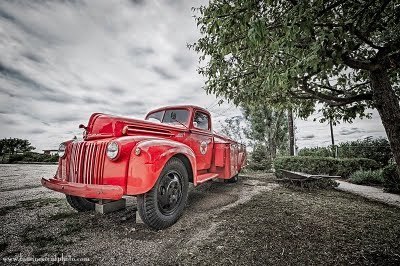



Some of these images, and the stories behind them, are published in my latest PDF eBook, "Field Notes: A Photographic Journey"Available for download here: http://www.luminescentphoto.com/fieldnotes/index.html
Like this post? Please share by clicking one of the links below.
All of these images were captured in eastern Colorado, in or around the town of Limon. While Limon is often seen as more of a "pit stop" for travelers along I-70 or US 24 in Colorado, there are actually some cool photographic subjects if you look for them.
I'm leading a workshop there on Sept 10-11, and there is one spot still open.
http://www.meetup.com/jason-odell-photo/events/26085341/







Some of these images, and the stories behind them, are published in my latest PDF eBook, "Field Notes: A Photographic Journey"Available for download here: http://www.luminescentphoto.com/fieldnotes/index.html
Like this post? Please share by clicking one of the links below.
Published on August 26, 2011 04:00
August 25, 2011
A Gift For You
What I'm reading: Betrayal of Trust, by J.A. Jance
A reminder that tonight (7 PM Eastern) I'll be hosting a chat at Savvy Authors . The subject is foreshadowing. Hope some of you can make it.
There's been a lot of talk about reviews around the blogosphere lately. Opinions as to their effectiveness vary. Some say they never read them. Some say they use them to help decide on book purchases. Some (myself included) read them after the fact to see if they agree or disagree with other reviewers.
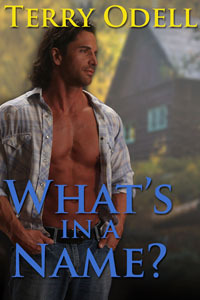
I don't think there's an answer, but I'm offering a free download to anyone who wants either WHAT'S IN A NAME? or DANGER IN DEER RIDGE. The hope, of course, is that you'll take a few minutes after reading and post a short review. However, I can't require it, nor would I want to. I'm happy enough that you'd want to read one of my books.
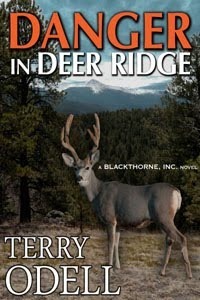
Here's how it works.
1. Decide which book you want. The best way is to go to my website and read the book blurbs, excerpts, and/or first chapter. WHAT'S IN A NAME? is here . DANGER IN DEER RIDGE is here . If one seems to be something you'd enjoy, then:
2. Email me at bookstore (at) terryodell (dot) com with "Free Book" in the subject line. Tell me which book you want, and how you'd like it delivered. Your choices:
3. A gift for your Kindle OR a coupon code to use at Smashwords.
For the Amazon gift, include the email address you use with your Kindle account so it will go to the right place. Would you like your copy "Kindlegraphed?" For Danger in Deer Ridge, click here . For What's in a Name? click
4. You can leave your review at Amazon, Barnes & Noble, Goodreads, or the Smashwords site, depending on where you downloaded the book.
5. If you enjoy the book, but you're not into reviewing, word of mouth is still the best advertising, so tell your friends.
6. Let me know how you found this post.
Tomorrow, Jason's back with more of his fantastic photography.
Like this post? Please share by clicking one of the links below.
A reminder that tonight (7 PM Eastern) I'll be hosting a chat at Savvy Authors . The subject is foreshadowing. Hope some of you can make it.
There's been a lot of talk about reviews around the blogosphere lately. Opinions as to their effectiveness vary. Some say they never read them. Some say they use them to help decide on book purchases. Some (myself included) read them after the fact to see if they agree or disagree with other reviewers.

I don't think there's an answer, but I'm offering a free download to anyone who wants either WHAT'S IN A NAME? or DANGER IN DEER RIDGE. The hope, of course, is that you'll take a few minutes after reading and post a short review. However, I can't require it, nor would I want to. I'm happy enough that you'd want to read one of my books.

Here's how it works.
1. Decide which book you want. The best way is to go to my website and read the book blurbs, excerpts, and/or first chapter. WHAT'S IN A NAME? is here . DANGER IN DEER RIDGE is here . If one seems to be something you'd enjoy, then:
2. Email me at bookstore (at) terryodell (dot) com with "Free Book" in the subject line. Tell me which book you want, and how you'd like it delivered. Your choices:
3. A gift for your Kindle OR a coupon code to use at Smashwords.
For the Amazon gift, include the email address you use with your Kindle account so it will go to the right place. Would you like your copy "Kindlegraphed?" For Danger in Deer Ridge, click here . For What's in a Name? click
4. You can leave your review at Amazon, Barnes & Noble, Goodreads, or the Smashwords site, depending on where you downloaded the book.
5. If you enjoy the book, but you're not into reviewing, word of mouth is still the best advertising, so tell your friends.
6. Let me know how you found this post.
Tomorrow, Jason's back with more of his fantastic photography.
Like this post? Please share by clicking one of the links below.
Published on August 25, 2011 04:00



